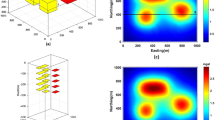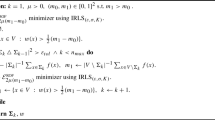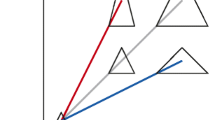Abstract
The discrete cosine transform (DCT) is described and then tested to see whether it is a suitable Fourier-related method for morphometric analysis of open outlines. While most Fourier methods are mainly effective with closed outlines, the DCT can handle open curves too, making it useful for quantitative descriptions of a broad range of natural objects. Like other Fourier-type methods, the DCT yields informative numerical signatures; the shape serves as input for subsequent multivariate analysis, with, for example, principal component analysis (PCA). To test the DCT as a morphometric tool, a set of 32 ammonite ribs was analyzed. The ammonites, representing 16 different species belonging to nine genera, were from the Hildoceratidae, a major Lower Jurassic family with essentially falcoid s.l. ribs, whose taxonomy is based largely on their ornamentation. Species were selected to illustrate the broad spectrum of ribbing patterns from almost straight to falcate via sigmoidal or falcoid, exhibited by the NW European Hildoceratidae. The first six harmonic amplitudes computed by the DCT were processed by PCA. The first three factorial axes of the PCA accounted for 87.2% of the total variance. Projections of the specimens on the first two factorial planes provide a well structured plot of the entire morphospace, demonstrating that the DCT is a promising and effective tool for morphometry.
Similar content being viewed by others
References
Ahmed N, Natarajan T, Rao KR (1974) Discrete cosine transform. IEEE Trans Comput C-23:90–93
Allen EG (2005) New approaches to Fourier analysis of ammonoid sutures and other complex, open curves. Paleobiology 32(2):299–315
Anstey RL, Delmet DA (1973) Fourier analysis of zooecial shapes in fossil tubular Bryozoans. Geol Soc Am Bull 84:1753–1764
Bookstein FL (1991) Morphometric tools for landmark data. Geometry and biology. Cambridge University Press, Cambridge, 435 p
Bookstein FL (1997) Landmark methods for forms without landmarks: morphometrics of group differences in outline shape. Med Image Anal 1(3):225–243
Bookstein FL, Chernoff B, Elder RL, Humphries JM, Smith GR, Strauss RE (1985) Morphometrics in evolutionary biology. The Academy of Natural Sciences, Philadelphia, Special publication 15, 277 p
Caloo B (1971) Caractères morphologiques non mesurables chez les Graphoceratinés (Ammonitina) (Aalenien au Nord de Digne, Basse-Alpes, France). Documents des Laboratoires de Géologie de la Faculté des Sciences de Lyon, vol 45, pp 1–18
Canfield DJ, Anstey RL (1981) Harmonic analysis of cephalopod suture patterns. Math Geol 13(1):23–35
Christopher RA, Waters JA (1974) Fourier series as quantitative descriptor of miospore shape. J Paleontol 48(4):697–709
Coster M, Chermant J-L (1989) Précis d’analyse d’image. CNRS, Paris, 560 p
Dommergues CH (2001) CDFT complex discrete Fourier tranform (Matlab package), Version 2.7. Biogéosciences-Dijon, UMR CNRS #5561
Dommergues E, Dommergues J-L, Magniez F, Neige P, Verrecchia EP (2003) Geometric measurement analysis versus Fourier series analysis for shape characterization using the gastropod Shell (Trivia) as an example. Math Geol 35(7):887–894
Dommergues J-L, Ferretti A, Mouterde R (1990) Des morphologies “Fuciniceras” platycônes aux morphologies “Protogrammoceras” sub-oxycônes. Réflexions sur les rôles des transformations de l’ontogenèse et de leur implications morpho-fonctionnelles. In: Pallini G, Cecca F, Cresta S, Santantonio M (eds) Fossili, evoluzione, ambiente (Atti del secondo convengo internazionale Pergola 25–30 Ottobre 1987). Comitato Centenario Raffaele Piccinini, Pergola, pp 229–251
El Hariri K (2001) Analyse morphométrique des côtes chez des Graphoceratidae (Ammonitina) du Maroc. Rev Paléobiol 20(2):367–376
El Hariri K, Neige P, Dommergues J-L (1996) Morphométrie des côtes chez les Harpoceratinae (Ammonitina) pliensbachiens. Comparaison des formes du Haut-Atlas (Maroc) avec celles de l’Apennin Central (Italie). C-R Acad Sci Paris Sér IIa 322:693–700
Gevirtz JL (1976) Fourier analysis of bivalve outlines. Implications on evolution and autecology. Math Geol 8:151–163
Gonzalez RC, Woods RE (2002) Digital image processing, 2nd edn. Prentice-Hall, Upper Saddle River, p 793
Howarth MK (1992) The ammonite family Hildoceratidae in the Lower Jurassic of Britain. Monograph of the Palaeontographical Society, vol 145, no 586, pp 1–106 and vol 146, no 590, pp 107–200
Kuhl FP, Giardina CR (1982) Elliptic Fourier features of a closed contour. Comput Graph Image Process 18:236–258
Lestrel P (1997) Fourier descriptors and their application in biological sciences. Cambridge University Press, Cambridge, 466 p
MacLeod N (1999) Generalizing and extending the eigenshape method of shape space visualization and analysis. Paleobiology 25(1):107–138
Moellering H, Rayner JN (1981) The harmonic analysis of spatial shapes using dual axis fourier shape analysis (DAFSA). Geograph Anal 13:64–77
Moellering H, Rayner JN (1982) The dual axis Fourier shape analysis of closed cartographic forms. Cartograph J 19:53–59
Navarro N, Zatarin X, Montuire S (2004) Effects of morphometric descriptor changes on statistical classification and morphospaces. Biol J Linnean Soc 83:243–260
Neige P, Dommergues J-L (1995) Morphometrics and phenetic versus cladistic analysis of the early Harpoceratinae (Pliensbachian ammonites). Neues Jahrb Geol Paläontol Abh 196(3):411–438
Pérez-Claros JA, Palmqvist P, Olóriz F (2002) First and second orders of suture complexity in ammonites: a new methodological approach using fractal analysis. Math Geol 34(3):323–343
Rao K, Yip P (1990) Discrete cosine transform: algorithms, advantages, applications. Academic, Boston, p 512
Raup DM (1961) The geometry of coiling gastropods. Proc Natl Acad Sci USA 47:602–609
Raup DM (1966) Geometric analysis of shell coiling. General problems. J Paleontol 40(5):1178–1190
Renaud S, Michaux J, Jaeger J-J, Auffray J-C (1996) Fourier analysis applied to Stephanomys (Rodentiaa, Muridae) molars. Nonprogressive evolutionary pattern in gradual lineage. Paleobiology 22(2):255–265
Rohlf FJ (1990) Fitting curves to outlines. In: Rohlf FJ, Bookstein FL (eds) Proceedings of the Michigan morphometrics workshop. University of Michigan Museum of Zoology, Ann Arbor, pp 167–177
Rohlf FJ, Archie JW (1984) A comparison of Fourier methods for the description of wing shape in mosquitoes (Diptera: Culicidae). Syst Zool 33:302–317
Schaaf A, Vansteelant ML (1988) La complexité morphologique linéaire en géologie. Comment la caractériser? Sci Géol Bull 41:319–346
Schmidt-Kittler N (1986) Evaluation of occlusal patterns of hypsodont rodent dentitions by shape parameters. Neues Jahrb Geol Paläontol Abh 173(1):75–98
Schmidttbulh M, Allenbach B, Le Minor JM, Schaaf A (2003) Elliptical descriptors. Some simplified morphometric parameters for the quantification of complex outlines. Math Geol 35(7):853–871
Spath LF (1913) On the Jurassic ammonites from the Jebel Zaghuan (Tunisia). Q J Geol Soc Lond 69:540–580
Toubin M, Dumont C, Verrecchia EP, Laligan O, Diou A, Truchetet F, Abidi MA (1999) Multiscale analysis of shell growth increments using wavelet transform. Comput Geosci 25(8):877–885
Verrecchia EP (2003) Image analysis and morphometry of geological objects. Math Geol 35(7):759–762
Verrecchia EP, Van Grootel G, Guillemet G (1996) Classification of Chitinozoaa (Llandoverian, Canada) using image analysis. Microsc Microanal Microstruct 7(5/6):461–466
Viriot L, Chaline J, Schaaf A (1990) Quantification du gradualisme phylétique de Mimomys occitanus à Mimomys ostramosensis (Arvicola, Rodentia) à l’aide de l’analyse d’image. C-R Acad Sci Paris Sér II 310:1755–1760
Wahba G (1990) Spline models for observational data. CBMS-NSF regional conference series in applied mathematics, vol 59. Society for Industrial and Applied Mathematics, Philadelphia, 169 p
Weisstein EW (2005) Star convex: MathWorld, a Wolfram Web resource, http://mathworld.wolfram.com/StarConvex.html
Younger JL, Ehrlich R (1977) Fourier biometric. Harmonic amplitudes as multivariate shape descriptors. Syst Zool 26(3):336–342
Zelditch ML, Swiderski HD, Fink WL (2004) Geometric morphometrics for biologists: a primer. Elsevier, London, 443 p
Author information
Authors and Affiliations
Corresponding author
Rights and permissions
About this article
Cite this article
Dommergues, C.H., Dommergues, JL. & Verrecchia, E.P. The Discrete Cosine Transform, a Fourier-related Method for Morphometric Analysis of Open Contours. Math Geol 39, 749–763 (2007). https://doi.org/10.1007/s11004-007-9124-6
Received:
Accepted:
Published:
Issue Date:
DOI: https://doi.org/10.1007/s11004-007-9124-6




